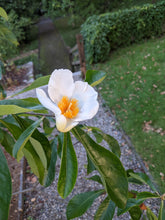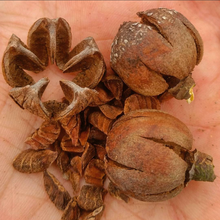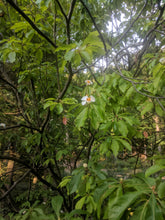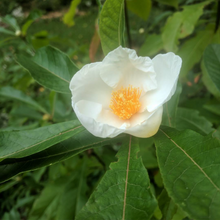Franklin Tree (Franklinia)
Regular price
$5.00
Sale
Franklinia alatamaha
Origin: Altamaha River, Georgia (via PA & NJ)
Improvement status: Wild
Seeds per packet: ~10
BOTANICAL SAMPLE - NOT GERMINATION TESTED
Life cycle: Perennial
By an unlikely set of circumstances, Philadelphia is the epicenter of cultivation of this gorgeous tree that happens to be extinct in the wild. It can be found in front yards of suburban homes, as specimen trees outside museums, in arboreta, on university campuses, and in public parks. It is something of a mascot for Bartram's Garden, the historic home and botanical garden of John Bartram, botanist to the King of England before the American Revolution, and his son and successor William.
Here's the story: Famed Philadelphia botanist John Bartram found a small population of this tree (which somewhat resembles a camellia or magnolia, but blooms in August or September) growing along the Altamaha River in coastal Georgia, north of the city of Brunswick, in 1765. His son William returned to the same spot on multiple occasions and was able to bring seed back in 1777, soon before his father's death. By 1781, the younger Bartram had produced flowering plants in Philadelphia and he soon named the tree after his father's great friend and contemporary Benjamin Franklin (who lived until 1790, so no doubt was aware of this honor). On a return trip, William went back to the exact same spot — but he couldn't find any trees. English plant collector John Lyon found the last verified living Franklinia in the wild in 1803, though it may have persisted for a few more decades. But since then it has never again been found growing in the wild.
Some speculate that Franklinia once grew up and down the eastern seaboard, but the glaciers of the last ice age pushed it south to Georgia, which eventually became too warm a place for it. It is considered a "glacial relict." But luckily it grows very well in Pennsylvania — even if it has a reputation for being rather finicky. Seedlings and cuttings from the original plants William Bartram cultivated are now grown by botanical gardens and plant lovers around the world.
Franklinia leaves make a pleasing-tasting tea substitute, and the deliciously fragrant flowers are very beautiful too, with long white petals and bright egg-yolk-yellow reproductive parts inside. The unique round seed pods, which split open in a zig-zag pattern, take 12 to 14 months to ripen. As a tree that flowers in August or September (when few other trees are flowering), it's great to have around for bees and other pollinators. The autumn leaves become a brilliant red before falling.
Few trees come with as fascinating a history — and you'd be hard-pressed to find any that are more beautiful either.
GROWING TIPS: Seeds should be cold-moist stratified for 1 to 2 months before planting. Additional heat also helps aid germination. Plants don't like their roots disturbed, so young seedlings should be put in their permanent position and not moved, however they can survive in pots for a few years before planting out. Strongly prefers acidic soil and lots of mulching around the base to keep down weed pressure. Keep plants well-watered while establishing.








